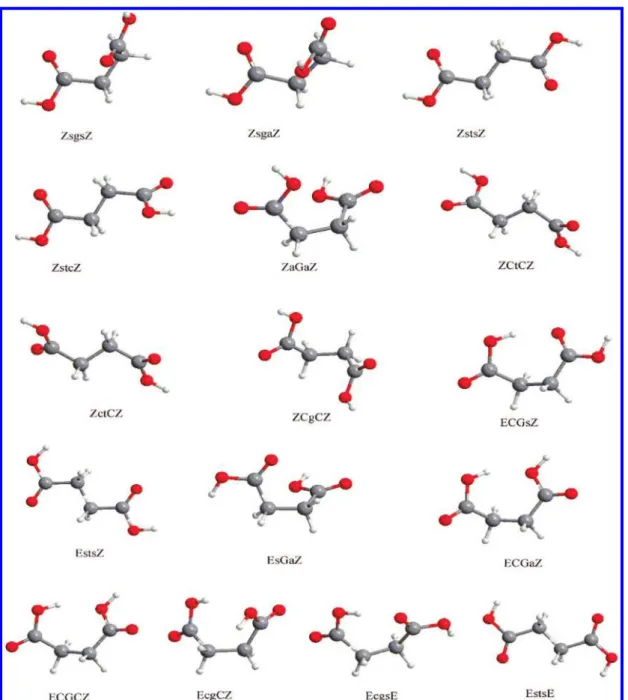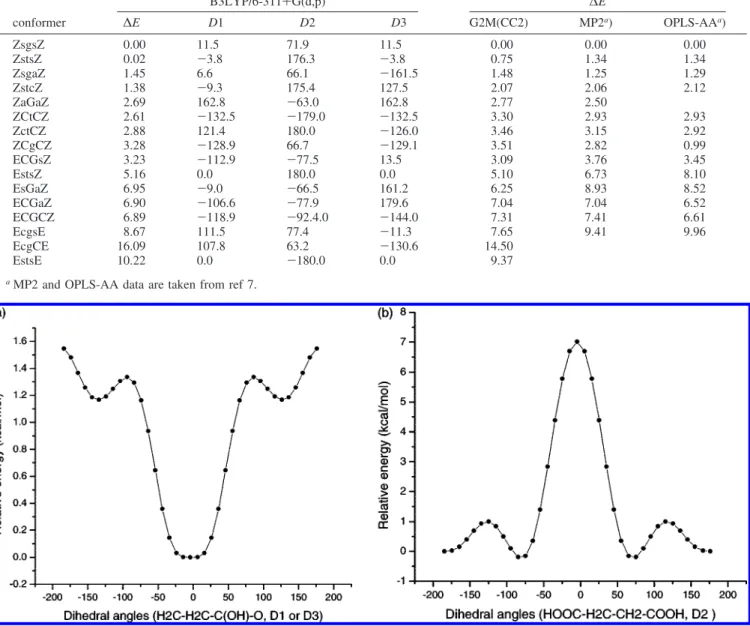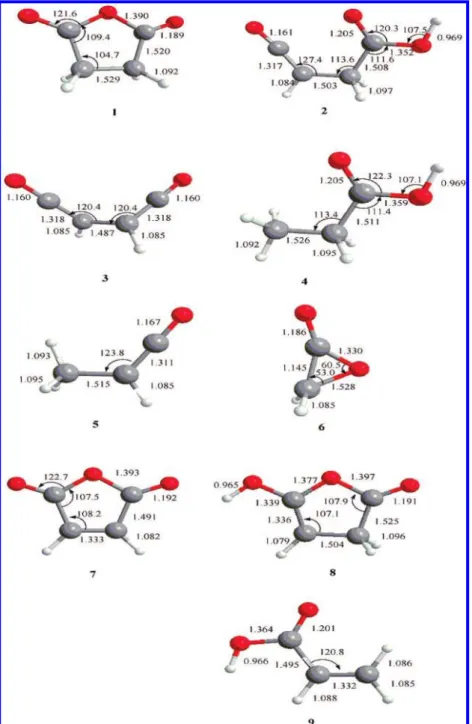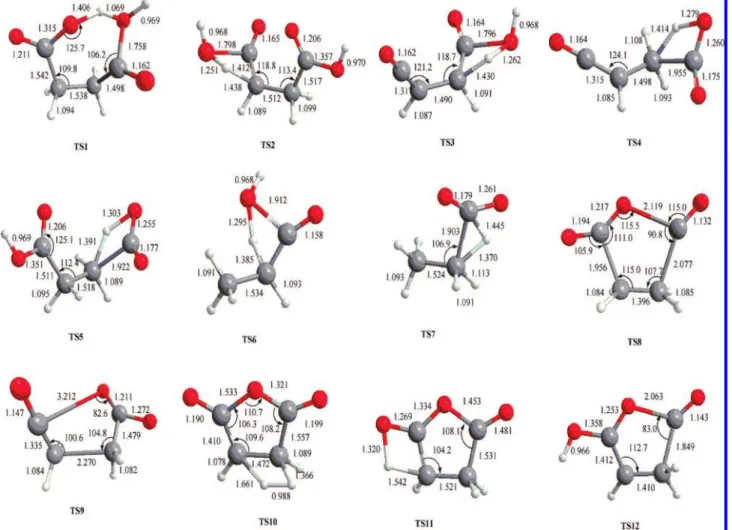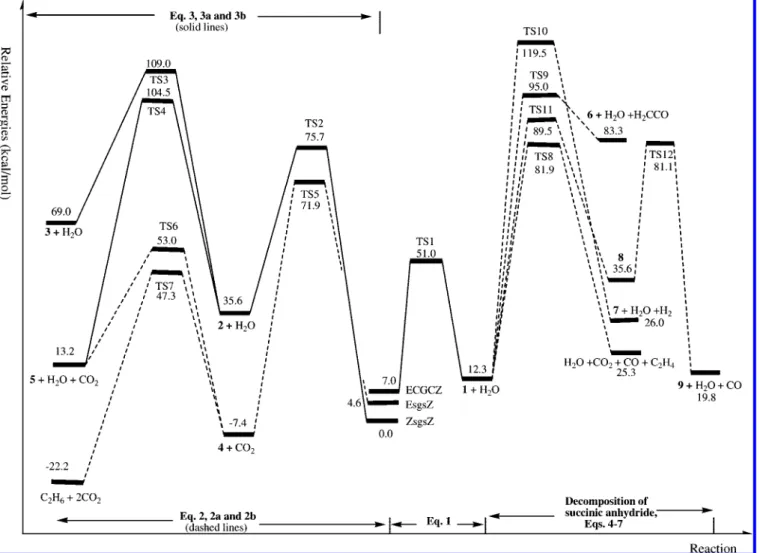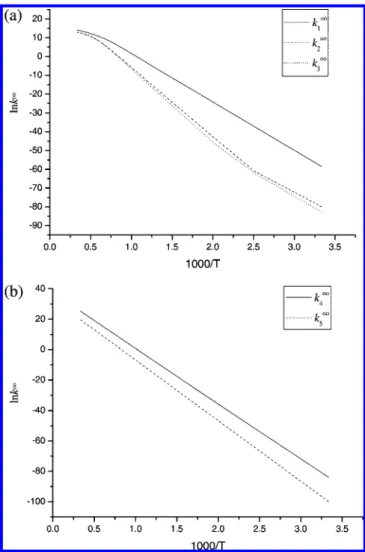Computational Study on Kinetics and Mechanisms of Unimolecular Decomposition of
Succinic Acid and Its Anhydride
Hsin-Tsung Chen,†,§Jee-Gong Chang,†,‡Djamaladdin G. Musaev,*,†and M. C. Lin*,†,§ Cherry L. Emerson Center for Scientific Computation, and Department of Chemistry, Emory UniVersity, Atlanta, Georgia 30322, National Center for High-performance Computing, No. 28, Nan-Ke 3rd Road, Hsin-Shi, Tainan 744, Taiwan, and Center for Interdisciplinary Molecular Science, National Chiao Tung UniVersity, Hsinchu 300, Taiwan
ReceiVed: March 5, 2008; ReVised Manuscript ReceiVed: May 5, 2008
The mechanisms and kinetics of unimolecular decomposition of succinic acid and its anhydride have been studied at the G2M(CC2) and microcanonical RRKM levels of theory. It was shown that the ZsgsZ conformer of succinic acid, with the Z-acid form and the gauche conformation around the central C-C bond, is its most stable conformer, whereas the lowest energy conformer with the E-acid form, ECGsZ, is only 3.1 kcal/mol higher in energy than the ZsgsZ. Three primary decomposition channels of succinic acid producing H2O +
succinic anhydride with a barrier of 51.0 kcal/mol, H2O + OCC2H3COOH with a barrier of 75.7 kcal/mol
and CO2 + C2H5COOH with a barrier of 71.9 kcal/mol were predicted. The dehydration process starting
from the ECGCZ-conformer is found to be dominant, whereas the decarboxylation reaction starting from the ZsgsZ-conformer is only slightly less favorable. It was shown that the decomposition of succinic anhydride occurs via a concerted fragmentation mechanism (with a 69.6 kcal/mol barrier), leading to formation of CO + CO2+ C2H4products. On the basis of the calculated potential energy surfaces of these reactions, the rate
constants for unimolecular decomposition of succinic acid and its anhydride were predicted. In addition, the predicted rate constants for the unimolecular decomposition of C2H5COOH by decarboxylation (giving C2H6
+ CO2) and dehydration (giving H3CCHCO + H2O) are in good agreement with available experimental data.
Introduction
Succinic acid (SA), also called amber acid or butanedioic acid, is one of the dicarboxylic acids with the molecular formula of C4H6O4 and was first purified from amber by Georgius
Agricola in 1546. It has been produced by microbial fermenta-tion for the use in agricultural, food and pharmaceutical industries.1 Commercially, SA is synthesized from liquefied
petroleum gases (LPG) or petroleum oil. SA is also found in samples of atmospheric aerosol particles,2which affect quality
of life3and the Earth’s radiative forcing.4SA has been widely
used as a precursor of many industrially important chemicals including adipic acid, 1,4-butanediol, tetrahydrofuran, N-me-thylpyrrolidinone, 2-pyrrolidinone, succinate salts and γ-buty-rolactone.5Recently, SA has been employed as an anti-ablative
material for boundary layer control system (BLCS) in high-pressure graphite rocket nozzle.6However, the thermal statistics
of SA and kinetics for its unimolecular decomposition are still unknown. It is also imperative to understand the high-temper-ature products of SA decomposition in a rocket propulsion system.
Previously, the conformational complexity of SA has been studied at ab initio and OPLS-AA levels of theory by Price et al.7It was shown that the ZsgsZ conformer (see Figure 1), its
Z-acid form with a gauche conformation around the central C-C bond, is the lowest energy conformer of SA. Its lowest energy conformer with an E-acid group and an internal hydrogen-bond
is about 3 kcal/mol higher in energy. However, in the literature there are no quantitative interpretations (both experimentally and theoretically) of the decomposition of the SA and its anhydride. Therefore, the present work is the first attempt on comprehensive studies of both conformational complexity and unimolecular decomposition mechanisms of SA and its anhy-dride. Here, we also predict the rate constants of all elementary reactions involved in the decomposition of SA.
Computational Methods
The geometries of the reactants, intermediates, transition states and products for succinic acid and its anhydride decomposition reactions in the gas phase have been optimized at the B3LYP/ 6-311+G(d,p) level of theory.8–10The vibrational frequencies
were calculated at the same level of theory to characterize the nature of the stationary points of the reported potential energy surfaces (PES) and to include zero-point energy (ZPE) correc-tions in the reported energetics. Intrinsic reaction coordinate (IRC)11calculations were performed to connect each reported
transition state with the associated reactants and products. To obtain more accurate energies and rate constants, we performed a series of single-point energy calculations for each stationary points of PESs with the modified GAUSSIAN-2 method,12the
G2M(CC2), which is based on the B3LYP/6-311+G(d,p) optimized geometries. The G2M(CC2) composite scheme is as follows:
E[G2M(CC2)] ) Ebas+ ∆E(+3df2p) + ∆E(CC) +
∆E(HLC,CC2) + ZPE where Ebas) E[PMP4(SDTQ)/6-311G(d,p)]
* Corresponding authors. E-mail: M.C.L., chemmcl@emory.edu; D.G.M., dmusaev@emory.edu.
†Emory University.
§National Chiao Tung University.
‡National Center for High-performance Computing.
10.1021/jp8019733 CCC: $40.75 2008 American Chemical Society Published on Web 06/27/2008
∆E(+3df2p) ) E[MP2/6-311+G(3df,2p) - MP2/6-311G (d,p)] ∆E(CC) ) E[CCSD(T)/6-311G(d,p) - PMP4
(SDTQ)/6-311G(d,p)] The higher level corrections, ∆E(HLC,CC2), are given by -5.3nβ - 0.19nR in milli-hartree, where nR and nβ are the numbers of R and β valence electrons, respectively. All calculations were performed by Gaussian_2003 quantum chemi-cal package.13
The microcanonical Rice-Ramsperger-Kassel-Marcus (RRKM) theory14–17was employed to calculate the rate constants
for the unimolecular decomposition reactions of succinicc acid and its anhydride by the ChemRate code.18
Results and Discussion
The optimized structures of the rotational conformers of SA are shown in Figure 1. The relative energies and the three
dihedral angles (D1 or D3, and D2) of the predicted conformers are presented in Table 1. Schematic energy change upon changing dihedral angles (D1, D2, and D3) from -180° to +180°by increments of 10°and optimizing all other geometries of the systems are depicted in Figure 2. In Figures 3 and 4 we present structures and geometries of the located intermediates, transition states and products of the unimolecular succinic acid decomposition reactions, and Figure 5 includes relative energies of these structures. Predicted first-order rate constants (in unit of s-1) for succinic acid and its anhydride decomposition in the temperature range 300-3000 K are shown in Figure 6.
1. Conformation of Succinic Acid (SA). Here we investigate the possible rotational conformers of SA. The internal rotational angles are schematically presented in Scheme 1.
Internal rotations around the C1-C2, C2-C3, and C3-C4,
called below as D1, D2, and D3, respectively, lead to sixteen
different conformers given in Figure 1.
The Cartesian coordinates of all optimized conformers are given in Table S1 of the Supporting Information. For notation
Figure 1. Located isomers of succinic acid calculated at the B3LYP/6-311+G(d,p) level. The ZPE and total energies of predicted conformers
of these conformers were have adopted the scheme proposed by Price et al.,7which includes five letters as UVWXY. Here,
U and Y stand for acid forms of SA and can be E or/and Z with near 180°and 0°rotational angles (O-C-O-H). V and X stand for angles D1 and D3, respectively, and can be a (anti) and/or s (syn), which stand for structures with near 180°and 0°rotational, D1 and D3, angles or can be c and C that stand for dihedral, D1 and D3, angles near +120° and -120°. W stands for rotational angle D2 and can be g and G indicating structures with near +60°and -60°rotational angles. We also will use (see below) notation t, which stands for trans for the
central dihedral (D2) angle. For example, EsGaZ refers to the diacid conformer (E and Z) with the O-C-O-H dihedral angle as 180°(E) and 0°(Z), the D1 and D3 angles as 0°(s, syn) and 180°(a, anti), and the central dihedral (D2) as -60°(G). As seen in Table 1, the ZsgsZ conformer with the two Z-acid forms of SA is the most stable structure among the all calculated conformers.
Its ZstsZ and ZsgaZ conformers are calculated to be only 0.75 and 1.48 kcal/mol higher in energy than the most stable ZsgsZ conformer. Additional stabilization of these two Z-acid forms of SA dictated by the additional interaction of the lone-pair of oxygen of the COOH group with theσ* orbital of the central C-C bond. This bonding scheme is supported by comparison of NBO (natural bond orbital) results for ZsgsZ, ZsgaZ, and ZstcZ conformers. As seen in Table 1, the relative energies of all isolated Z-acid conformers are within 3.5 kcal/ mol. Conformers with mixed (E and Z) acid forms are grouped within 3.09-7.31 kcal/mol, ECGsZ and ECGCZ being lowest and highest in energy among them, respectively. The located structures, EcgsE, EcgCE and EstsE, with the two E-acid forms, are found to be 7.65, 14.50, and 9.37 kcal/mol higher in energy TABLE 1: Relative Energies (kcal/mol) and Dihedral Angles (deg) D1, D2 and D3 of Predicted Conformers of Succinic Acid, Calculated at the Different Levels of Theory
B3LYP/6-311+G(d,p) ∆E
conformer ∆E D1 D2 D3 G2M(CC2) MP2a) OPLS-AAa)
ZsgsZ 0.00 11.5 71.9 11.5 0.00 0.00 0.00 ZstsZ 0.02 -3.8 176.3 -3.8 0.75 1.34 1.34 ZsgaZ 1.45 6.6 66.1 -161.5 1.48 1.25 1.29 ZstcZ 1.38 -9.3 175.4 127.5 2.07 2.06 2.12 ZaGaZ 2.69 162.8 -63.0 162.8 2.77 2.50 ZCtCZ 2.61 -132.5 -179.0 -132.5 3.30 2.93 2.93 ZctCZ 2.88 121.4 180.0 -126.0 3.46 3.15 2.92 ZCgCZ 3.28 -128.9 66.7 -129.1 3.51 2.82 0.99 ECGsZ 3.23 -112.9 -77.5 13.5 3.09 3.76 3.45 EstsZ 5.16 0.0 180.0 0.0 5.10 6.73 8.10 EsGaZ 6.95 -9.0 -66.5 161.2 6.25 8.93 8.52 ECGaZ 6.90 -106.6 -77.9 179.6 7.04 7.04 6.52 ECGCZ 6.89 -118.9 -92.4.0 -144.0 7.31 7.41 6.61 EcgsE 8.67 111.5 77.4 -11.3 7.65 9.41 9.96 EcgCE 16.09 107.8 63.2 -130.6 14.50 EstsE 10.22 0.0 -180.0 0.0 9.37
aMP2 and OPLS-AA data are taken from ref 7.
Figure 2. Energy diagram of the reported conformers as a function of dihedral angles (a) D1 or D3, and (b) D2.
than ZsgsZ, respectively. Structurally, ECGsZ, ECGaZ, ECGCZ, EcgCZ, and EcgsE (see Figure 1) have an internal hydrogen bond; the H-bonding lengths are 1.847, 1.944, 1.868, 2.333, and 1.845 Å, respectively. Earlier theoretical studies7based on
the Hartree-Fock (HF), MP2, and OPLS-AA levels of theory gave consistent results. HF/6-31G(d) calculations predicted ZsgsZ to be 0.59 and 4.86 kcal/mol more stable than ZstsZ and ECGsZ, whereas MP2/6-31G(d)//HF/6-31G(d) and OPLS-AA calculations predicted ZsgsZ to be 1.3 and 3.8, and 1.3 and 3.5 kcal/mol more stable than ZstsZ and ECGsZ, respectively. Our G2M (CC2) results are in good agreement with the high level MP2/6-31G(d)//HF/6-31G(d) and OPLS-AA calculations.
Thus, the Z-acid form of SA is more stable than mixed (E/ Z)- and E-acid forms, which is also observed in acetic acid.19
The Z-acid form of acetic acid is 4.95 kcal/mol lower than E-acid form at the MP2/6-311+G(d,p)//HF/6-31G(d) level of theory.
So, it can be concluded that the E-acid conformers of SA will not be significantly populated near room temperature in the gas phase.
To elucidate the conformation mechanisms of SA, we have scanned potential energy surfaces (PES) of the specific processes by changing the corresponding dihedral angles D1(or D3), and D2 from -180°to +180°by 10°increments. At the each fixed value of the given angle all other geometry parameters were fully optimized. The calculated PES’s at the B3LYP/6-311+G(d,p) level are depicted in Figure 2.
As seen from these figures, global minimum on these PESs correspond to 0°and 75°of D1 (or D3) and D2, respectively. These data, once again, show that the ZsgsZ conformer is the most stable one, which is also consistent with the gauche effect.20–22The calculated barriers are 1.33 and 1.54 kcal/mol
at 86.1°(or -93.9°) and 176.1°(or -183.9°) for the D1 (or
Figure 3. Located intermediates of unimolecular decomposition of succinic acid and its anhydride and their important geometry parameters calculated
D3) rotation; and 0.99 and 7.01 kcal/mol at 115.3°(or -124.7°) and -4.7°for the D2 rotation. Thus, the internal rotations around the C-C bond of SA (D1, D2 and D3 rotations) occur easily. 2. Mechanisms for Decomposition of Succinic Acid (SA). In Figures 3 and 4 we present all intermediates, transition states, and products of the unimolecular succinic acid decomposition. Their calculated geometrical parameters are given in Table S2, and relative energies are schematically presented in Figure 5. As seen from Scheme 2, the first proposed reaction (eq 1) is a dehydration of SA leading to water molecule and succinic anhydride, which could decompose further (see Scheme 3). The proposed second reaction associates with a subsequent dehydra-tion (eq 2a) and dehydradehydra-tion-then-decarbonyladehydra-tion (eq 2b) mechanisms. The last proposed reaction of unimolecular succinic
acid decomposition is a decarbonylation-then-dehydration (eq 3a) and subsequent decarbonylation (eq 3b) processes. In addition, we compared the available experimental data for the heats of the reactions succinic acid f succinic anhydride + H2O (eq 1) and succinic acid f CH3CH2COOH + CO2(eq 3).
The calculated values of +11.3 and -9.7 kcal/mol at 298 K are both in good agreement with the experimental values of +11.2 ( 0.02 and -8.8 ( 0.48 kcal/mol reported by Kistia-kowsky et al.23aand NIST thermochemical tables.23b
First, we discuss the dehydration of SA. As seen in Scheme 2, dehydration of SA may start from two different conformers, ECGCZ and ZsgsZ, energy difference between which is only 7.0 kcal/mol. Dehydration from the conformer ECGCZ (eq 1) occurs via H-migration from one of the COOH groups to another SCHEME 2
Figure 4. Located transition states of unimolecular decomposition of succinic acid and its anhydride and their important geometry parameters
COOH group and leads to formation of cyclic C4H4O3product
and water molecule, i.e., intermediate 1 (succinic anhydrite) + H2O. This process is calculated to be 5.3 kcal/mol endothermic
and proceeds with a 44.0 kcal/mol barrier at the concerted transition state TS1 (see Figures 4 and 5). In TS1, the forming C-O bond and the breaking O-H bond are calculated to be 2.181 and 1.406 Å, respectively (Figure 4). The product of this reaction is a cyclic compound C4H4O3(Figure 3).
Energetically, the most stable isomer of SA, ZsgsZ, can also decompose via dehydration pathway (eq 2). As seen in Figures 3–5, dehydration of ZsgsZ leads to formation of OCC2H3COOH
(intermediate 2) + H2O, which occurs via a concerted
(simul-taneous C-OH bond cleavage and H-migration from CH2to
OH) transition state TS2. This process is calculated to be endothermic by 35.6 kcal/mol and proceeds with a 75.7 kcal/ mol energy barrier. The geometry of the located TS2 is consistent with the nature of the proposed process: In TS2, the bond distances of the breaking HC-H, C-OH bonds and forming HO-H bond are 1.438, 1.798, and 1.251 Å, respec-tively. Because in the formed intermediate 2 the second CH2
and COOH fragments are still intact, reaction may follow via a formation of the second water molecule (eq 2a). Calculations show that reaction 2 f H2O + 3 is also endothermic, by almost
the same value as the first dehydration process (from the ZsgsZ), 33.4 kcal/mol, and occurs with a 78.4 kcal/mol barrier. Thus, the subsequent dehydration of SA is an additive process. Overall double dehydration of SA, ZsgsZ f 2H2O + 3, requires 109.0
kcal/mol barrier and is endothermic by 69 kcal/mol.
The intermediate 2, product of the first dehydration of ZsgsZ, may also undergo decarboxylation to form CO2and intermediate
5 (eq 2b). As seen in Figure 5, in fact, decarbonylation of 2 is slightly more favorable than its dehydration. Indeed, decarbo-nylation of 2 is found to proceed with a 68.9 kcal/mol barrier at transition state TS4, and is 22.4 kcal/mol exothermic to give CO2+ H3CCHCO (5) products. Overall dehydration followed
by decarbonylation (i.e., dehydration-then-decarbonylation, eq 2b) of SA, ZsgsZ f H2O + CO2+ H3CCHCO (5), is found to
be endothermic by 13.2 kcal/mol, and proceeds with 104.5 kcal/ mol barrier at TS4.
Now, we discuss the mechanism of SA decomposition via the decarbonylation pathway (eq 3). This process involves migration of H from COOH-fragment to CH2. It starts from
EsgsZ conformer of SA (which is a 4.6 kcal/mol higher in energy than the most stable conformer EsgsZ) and leads to C2H5COOH (4) and CO2. It occurs via a TS5, where
simulta-neously HOOC-CH2 bond cleaves and H migrates from the
COOH fragment to CH2. As seen in Figure 4, in TS5, the
forming C-H bond and the breaking O-H and C-C bonds are 1.391, 1.303, and 1.922 Å, respectively. The barrier associated with this transition state is 71.9 kcal/mol. Reaction EsgsZ f CO2+ C2H5COOH (4) is found to be exothermic by
7.4 kcal/mol. From the formed intermediate 4 reaction may proceed via two different pathways: dehydration (called as decarbonylation-then-dehydration, eq 3a) and decarbonylation (the formation of the second carbonyl dioxide, eq 3b). The first pathway occurs via transition state TS6 and associated 60.4 kcal/
Figure 5. Schematic presentation of energetics of unimolecular decomposition reactions of succinic acid and its anhydride calculated at the
mol barrier and leads to H2O + H3CCHCO (5) products. This
process is found to be a 20.6 kcal/mol endothermic. However, decarbonylation of C2H5COOH (4) occurs with a slightly less
barrier, 54.7 kcal/mol, at transition state TS7, and is exothermic by 14.8 kcal/mol.
Thus, the above-presented results clearly show that direct dehydration and decarbonylation of the energetically lowest conformer of SA, ZsgsZ, is kinetically and thermodynamically less favorable. However, it can easily rearrange to excited conformers, such as ECGCZ and EsgsZ, which decompose relatively easier via the dehydration (to lead succinic anhydride) and decarbonylation (to lead 2CO2+ C2H6products) pathways.
The first channel (eq 1), dehydration of SA with formation of 1 (succinic anhydride) and H2O molecule looks kinetically and
thermodynamically more favorable. Therefore, below, we study the processes starting from the intermediate 1 (succinic anhy-dride) in more details.
As mentioned above, the decomposition mechanism of C2H5COOH involves two channels: (1) dehydration (giving
H3CCHCO + H2O; eq 3a) and (2) dehydrogenation (giving
C2H6 + CO2; eq 3b). The effect of quantum-mechanical
tunneling on the decomposition reactions has been considered. The predicted rate constants for the unimolecular dehydration and decarboxylation processes in the temperature range 700-1000 K at 100 Torr average experimental pressure are given by k3a
) 1.52 × 109exp(-48.86 cal mol-1/RT) s-1and k
3b) 5.12 ×
109 exp(-44.17 cal mol-1/RT) s-1. Our results are in good
agreement with the experimental values for both product channels.24The predicted overall activation energy is 44.2 kcal/
mol is in excellent agreement with experimental value of 43.3 kcal/mol.24
3. Mechanisms for Decomposition of Succinic Anhydride, 1. On the basis of our extensive preliminary analysis, we have proposed four decomposition pathways for succinic anhydride (Scheme 3).
First of them is the pathway leading to C2H4+ CO2+ CO
products. This reaction occurs with a concerted five-membered transition state, TS8, where the breaking C-C and C-O bonds are 1.956, 2.077, and 2.119 Å, respectively. The barrier associated with this transition state is 69.6 kcal/mol. The overall reaction 1 f C2H4+ CO2+ CO is found to be endothermic
by 13.0 kcal/mol. The second proposed decomposition pathway of succinic anhydride leads to the H2CCO and cyclic H2C(O)CO
intermediate 6. It proceeds through TS9. Energy barrier associ-ated with this transition state is 82.7 kcal/mol barrier. The entire reaction 1 f H2CCO + H2C(O)CO (6) is found to be
endothermic by 71.0 kcal/mol. As seen in Figure 4, at transition state TS9, breaking C-C and C-O bonds are elongated to 2.270 and 3.212 Å, respectively. The third proposed pathway is a dehydrogenation reaction leading to formation of the maleic anhydride, intermediate 7 (C4H2O3) and dihydrogen molecule.
This process occurs with a high-energy barrier (107.2 kcal/mol) at transition state TS10 and is 13.7 kcal/mol endothermic. As seen in Figure 4, the forming H2 molecule results from the
H2CdCH2unit: the breaking C-H bonds are 1.661 Å and the
forming H-H bond distance is 0.988 Å in transition state TS10. The first step of the last (fourth) proposed channel for succinic anhydride decomposition is the H-migration from the CH2-group
to the CO-unit to form intermediate 8, C4H4O3with a terminal
OH-group. The calculated barrier for this H-migration process is found to be a 77.2 kcal/mol at transition state TS11. The resulting reaction 1 f 8 is endothermic by 23.3 kcal/mol. At the next stage, intermediate 8 decomposes to C2H3COOH (9)
+ CO via a barrier of 45.5 kcal/mol at transition state TS12. Thus, the overall reaction 1 f 8 f C2H3COOH (9) + CO
occurs with a 77.2 kcal/mol barrier at TS11 and is endothermic by 7.5 kcal/mol.
Thus, on the basis of the above-presented discussion (Figure 5), the kinetically and energetically most visible channels of succinic anhydride decomposition are those leading to CO2+
CO + C2H4and C2H3COOH (9) + CO, which proceed by 69.6
and 77.2 kcal/mol rate-limiting barriers, and are endothermic by 13.0 and 7.5 kcal/mol, respectively.
4. Rate Constant Calculations. The microcanonical Rice-Ramsperger-Kassel-Marcus (RRKM) theory was employed to calculate the rate constants for the unimolecular decomposi-tion of SA and its anhydride. The effect of quantum-mechanical tunneling on the decomposition reactions have been considered (on the basis of the Eckart model implemented in the ChemRate program18). The moments of inertia and vibrational frequencies
of reactants and transition states presented in Table S2 were
Figure 6. Predicted first-order rate constants (in unit of s-1) in the temperature range 300-3000 K for decomposition of (a) succinic acid (k1∞, k2∞, and k3∞) and (b) succinic anhydride (k4∞, and k5∞).
used. The Lennard-Jones (L-J) parameters employed for the succinic acid decomposition reaction are as follows: Ar,σ ) 4.42 Å,ε/k ) 164 K and succnic acid, σ ) 5.30 Å, ε/k ) 676 K. For the succnic anhydride system they are as follows: Ar,σ ) 4.33 Å, ε/k ) 171 K and succnic anhydride, σ ) 5.12 Å, ε/k ) 735 K using the formulas (ε/k ) 0.897Tc,σ ) 0.785Vc1/3).25
The energy-transfer process was computed on the basis of the exponential down model with a〈∆E〉downvalue (the mean energy
transferred per collision) of 400 cm-1for Ar. The multichannel models were used in the rate constant calculations.
As shown in the PES, the decomposition channels of SA takes place by the eqs 1, 2, and 3 shown in Scheme 2, for which the rate constants are controlled by the well-defined TS1, TS2, and TS5, respectively. Figure 6 displays the predicted rate constants of k1∞, k2∞and k3∞in the temperature range 300-3000 K. The
results show that the thermal decomposition of SA should be dominated by the dehydration process to produce the succinic anhydride in the whole temperature range. At the high pressure, the thermal decomposition rate constant including the contribu-tions from other conformers of succinic acid defined by d[C4H4O3]/dt ) k∞[(CH2COOH)2]0)
∑
ki∞Xi) kx∞[X] +kA∞[A] + kB∞[B] + ... + kO∞[O] where [(CH2COOH)2]0, [X], [A], [B],..., [O] are the initial
concentration of ZsgsZ, ZstsZ, ZsgaZ,..., EstsE, respectively, under thermal equilibrium, and the ki∞are the first-order rate constant for the decomposition from these conformers. Assum-ing KA, KB,..., and KOto be the equilibrium constant for ZsgsZ
fZstsZ, ZsgsZ f ZsgaZ,..., ZsgsZ f EstsE, respectively, leads to the total rate constant:
k∞) (kx+ kAKA+ kBKB+ ... + kOKO) ⁄ (1 + KA+ KB+ ... +
KO) The rate constants for these key decomposition reactions have been calculated for 1 and 100 atm, and the high-pressure limit in the temperature range 300-3000 K is expressed as the following equations:
k11atm) 2.77×1014T-0.00371exp(-53.88 kcal mol-1/RT) s-1
k1100atm)
3.28×1013T-0.0172exp(-52.93 kcal mol-1/RT) s-1
k1∞) 3.31×1013T-0.00272exp(-53.04 kcal mol-1/RT) s-1
k21atm) 3.17×1014T-0.00453exp(-72.75 kcal mol-1/RT) s-1
k2100atm)
4.01×1013T-0.00137exp(-69.38 kcal mol-1/RT) s-1
k2∞) 1.42×1013T-0.00157exp(-68.36 kcal mol-1/RT) s-1
k3
1atm) 5.41×
1014T-0.00452exp(-70.32 kcal mol-1/RT) s-1
k3 100atm)
2.60×1013T-0.00115exp(-71.98 kcal mol-1/RT) s-1
k3
∞) 1.15×
1013T-0.00132exp(-70.04 kcal mol-1/RT) s-1 The overall rate constants for succinic acid decomposition should be expressed as
k1+2+3 1atm)
2.76×1014T-0.0037exp(-53.88 kcal mol-1/RT) s-1
k1+2+3 100atm)
3.89×1013T-0.00162exp(-52.87 kcal mol-1/RT) s-1
k1+2+3
∞)
2.27×1013T-0.00241exp(-52.85 kcal mol-1/RT) s-1 In addition, the following decomposition channels of the succinic anhydride produce CO + CO2 + C2H4 (eq 4) and CO +
C2H3COOH (eq 7) as also shown in Figure 4 and Scheme 3.
The decomposition rate constant of succinic anhydride in the temperature range 300-3000 K can be given as follows: k41atm) 1.35×1017T-0.00527exp(-68.42 kcal mol-1/RT) s-1
k4100atm) 1.62×1017T-000364exp(-691 kcal mol-1/RT) s-1
k4∞) 1.68×1016exp(-72.23 kcal mol-1/RT) s-1
k51atm) 6.36×1013T-0.00225exp(-72.93 kcal mol-1/RT) s-1
k5100atm)
3.62×1012T-0.00006exp(-71.39 kcal mol-1/RT) s-1
k5∞) 2.14×1014exp(-78.90 kcal mol-1/RT) s-1 The overall rate constants for succinic anhydride decomposition should be expressed as
k4+51atm)
1.30×1017T-0.0009exp(-68.09 kcal mol-1/RT) s-1
k4+5 100atm)
1.58×1017T-0.00016exp(-68.98 kcal mol-1/RT) s-1
k4+5
∞) 1.68×
1016exp(-72.23 kcal mol-1/RT) s-1 Conclusions
The conformational analysis and unimolecular decomposition mechanisms of succinic acid (SA) as well as its anhydride have been studied at the G2M (CC2) level of theory. The microca-nonical RRKM method was applied to calculate the kinetics of the studied unimolecular decomposition processes. The relative energies of all isolated Z-acid conformers are within 3.5 kcal/ mol, the ZsgsZ conformer with the gauche conformation around the central C-C bond is its most stable conformer. Conformers with mixed (E and Z) acid forms are grouped within 3.09-7.31 kcal/mol, with ECGsZ and ECGCZ being the lowest and highest in energy among them, respectively. The located three E-acid form structures, EcgsE, EcgCE, and EstsE, are found to be 7.65, 14.50, and 9.37 kcal/mol higher in energy than ZsgsZ, respec-tively. For the succnic acid decomposition, the dehydration process (H2O + succinic anhydride) starting from the
ECGCZ-conformer is found to be dominant, whereas the decarboxylation reaction (CO2 + C2H5COOH) starting from the
ZsgsZ-conformer is only slightly less favorable. In addition, the decomposition of its anhydride takes place via a concerted fragmentation mechanism (with a 69.6 kcal/mol barrier) leading to formation of CO + CO2+ C2H4products. The rate constants
for unimolecular decomposition of succinic acid and its anhydride have been computed in the temperature range 300-3000 K. The predicted rate constants may be employed for practical applications.
Acknowledgment. We gratefully acknowledge: (1) financial support from the Office of Naval Research under a MURI grant
(Prime Award # N00014-04-1-0683 and Subaward # 2794-EU-ONR-0683), (2) the Emerson Center for the use of its resources, and (3) the use of CPU’s from National Center for High-performance Computing, Taiwan. M.C.L. acknowledges the support from National Science Council of Taiwan for this distinguished visiting professorship. J.-G.C. acknowledges the financial support from the Emerson Center Visiting Fellowship of Emory University.
Supporting Information Available: Complete ref 13. Table S1, Cartesian coordinates of all optimized isomers of succinic acid; Table S2, calculated Cartesian coordinates of intermedi-ates, transition states and products of the unimolecular succinic acid and its anhydride decomposition; Table S3, ZPE and total energies of all conformers calculated at B3LYP/6-311+G(d,p) and G2M(CC2); Table S4, frequencies and moments of inertia Iiof the decomposition reaction of succinic acid and succinic anhydride calculated at the B3LYP/6-311+G(d,p) level. This material is available free of charge via the Internet at http:// pubs.acs.org.
References and Notes
(1) Zeikus, J. G.; Jain, M. K.; Elankovan, P. Appl. Microbiol.
Biotechnol. 1999, 51, 545.
(2) Grosjean, D.; van Cauwenberghe, K.; Schmid, J. P.; Kelley, P. E.; Pitts, J. EnViron. Sci. Technol. 1978, 12, 313.
(3) Dockery, D. W.; Pope, C. A. Annu. ReV. Public Health 1994, 15, 107.
(4) Stott, P. A.; Tett, S. F. B.; Jones, G. S.; Allen, M. R.; Mitchell, J. F. B.; Jenkins, G. J. Science 2000, 290, 2133.
(5) Song, H.; Lee, S. Y. Enzyme Microbiol. Technol. 2006, 39, 352. (6) Kuo, K. K.; Acharya, R.; Boyd, E.; Thynell, S. T. Pyrolysis Study of SA/PVA as Ablative Material for Boundary Layer Control System in High-pressure Graphite Rocket Nozzle; AIAA/ASME/SAE/ASEE Joint Propulsion Conference, 2007.
(7) Price, D. J.; Roberts, J. D.; Jorgensen, W. L. J. Am. Chem. Soc.
1998, 120, 9672.
(8) Becke, A. D. J. Chem. Phys. 1992, 96, 2155. (9) Becke, A. D. J. Chem. Phys. 1992, 97, 9173. (10) Becke, A. D. J. Chem. Phys. 1993, 98, 564.
(11) GonzalezC. SchlegelH. B. J. Chem. Phys. 1989, 90, 2154; J. Phys.
Chem. 1990 94, 5523.
(12) Mebel, A. M.; Morokuma, K.; Lin, M. C. J. Chem. Phys. 1995,
103, 7414.
(13) Frisch, M. J.; et al. Gaussian 03, revision C.02; Gaussian, Inc., Wallingford, CT, 2004.
(14) Klippenstein, S. J. J. Chem. Phys. 1992, 96, 367.
(15) Klippenstein, S. J.; Marcus, R. A. J. Chem. Phys. 1987, 87, 3410. (16) Wardlaw, D. M.; Marcus, R. A. Chem. Phys. Lett. 1984, 110, 230. (17) Wardlaw, D. M.; Marcus, R. A. J. Chem. Phys. 1985, 83, 3462. (18) Mokrushin, W. B., V.; Tsang, W.; Zachariah, M.; Knyazev, V.
ChemRate, version 1.5.2 ed.; National Institute of Standards and Technology:
Gaithersburg, MD, 2006.
(19) Rablen, P. R. Personal communication.
(20) Alema´n, C.; Puiggalı´, J. J. Org. Chem. 1997, 62, 3076. (21) Wiberg, K. B. Acc. Chem. Res. 1996, 29, 229. (22) Wolfe, S. Acc. Chem. Res. 1972, 5, 102.
(23) (a) Conn, J. B.; Kistiakowsky, G. B.; Roberts, R. M.; Smith, E. A. Heats of organic reactions. XIII. Heats of hydrolysis of some acid anhydrides. J. Am. Chem. Soc. 1942, 64, 1747. (b) The heats of formation at 298 K for succinic anhydride and CH3CH2COOH,-126.2 ( 0.41
and-108.9 ( 0.48 kcal/mol, are taken from the NIST website: http://www.nist-.gov/.
(24) Blake, P. G.; Hole, K. J. J. Chem. Soc. B 1966, 577.
(25) Mourits, F. M.; Rummens, F. H. A. Can. J. Chem. 1977, 55, 3007. JP8019733
